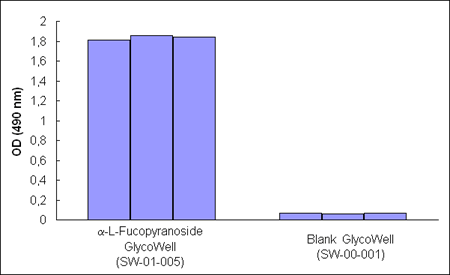TechNotes No. 6-2000
Binding of a plant lectin — horseradish peroxidase conjugate
to a-L-fucopyranoside GlycoWell™ plates.
Introduction
Binding of lectins to immobilized surfaces and subsequent
inhibition of such a binding event is often used for evaluating lectin inhibitors.
The use of GlycoWell™ plates facilitates an ELISA assay involving the binding
of lectins to the wells. This TechNote describes the binding of an a-L-fucopyranoside
recognizing lectin, Ulex europaeus 1, to a-L-fucoopyranoside
GlycoWell™ plates.
Experimental
- Lectin
incubation. Add 100 µL lectin solution to each well. Leave for 45 min
- Washing.
Empty the wells and wash three times with CovaBuffer. Leave the last wash in the
wells for 15 min. Wash with citrate/phosphate buffer once.
- Substrate
reaction. Add 100 µL substrate solution to each well. Read optical density
at 490 nm in a microwell plate reader.
Discussion
The results demonstrate that an a-L-fucopyranoside
GlycoWell™ plate efficiently binds an a-L-fucopyranoside-recognizing
plant lectin, Ulex europaeus (Figure 1). Thus, GlycoWell plates are suitable
for detecting carbohydrate binding properties of proteins.
Materials
- GlycoWell™ plates SW-00-001 (N-acetyl,
blank) and SW-01-005 (a-L-fucopyranoside).
- PBS buffer pH 7.2, 0.15 M Na+: 24.0 g NaCl,
0.6 g KCl, 3.46 g Na2HPO4·2H2O, 0.6 g KH2PO4,
3 L H2O.
- TWEEN/PBS: 0.10 mL TWEEN 20, 200 mL
PBS.
- CovaBuffer: 116.9 g NaCl, 10.0 g MgSO4·7H2O,
0.50 mL TWEEN 20, 1 L PBS.
- Citrate-Phosphate buffer, pH
5.0: 7.30 g citric acid, 11.86 g Na2HPO4·2H2O,
1 L H2O.
- Lectin stock: 1.0 mg Ulex europaeus
-horseradish peroxidase conjugate (SIGMA L8146), 1.0 mL TWEEN/PBS.
-
Lectin solution: 70 µL Lectin stock, 1.75 mL TWEEN/PBS, filtered through a 0.22
micron filter.
- Substrate solution: 6.0 mg o-phenylenediamine,
10.0 mL citrate/phosphate buffer, 5 µL H2O2, freshly prepared.
 Figure 1. A Ulex europaeus
-horseradish peroxidase conjugate binds to an a-L-fucopyranoside
GlycoWell™ plates (SW-01-005), but not to a GlycoWell™ plate devoid of saccharide
(SW-00-001).
Figure 1. A Ulex europaeus
-horseradish peroxidase conjugate binds to an a-L-fucopyranoside
GlycoWell™ plates (SW-01-005), but not to a GlycoWell™ plate devoid of saccharide
(SW-00-001). |
Reference
1. Matsumoto, I. and Osawa, T. Biophys. Acta, 1969, 194, 180.
 Figure 1. A Ulex europaeus
-horseradish peroxidase conjugate binds to an a-L-fucopyranoside
GlycoWell™ plates (SW-01-005), but not to a GlycoWell™ plate devoid of saccharide
(SW-00-001).
Figure 1. A Ulex europaeus
-horseradish peroxidase conjugate binds to an a-L-fucopyranoside
GlycoWell™ plates (SW-01-005), but not to a GlycoWell™ plate devoid of saccharide
(SW-00-001).  Figure 1. A Ulex europaeus
-horseradish peroxidase conjugate binds to an a-L-fucopyranoside
GlycoWell™ plates (SW-01-005), but not to a GlycoWell™ plate devoid of saccharide
(SW-00-001).
Figure 1. A Ulex europaeus
-horseradish peroxidase conjugate binds to an a-L-fucopyranoside
GlycoWell™ plates (SW-01-005), but not to a GlycoWell™ plate devoid of saccharide
(SW-00-001).